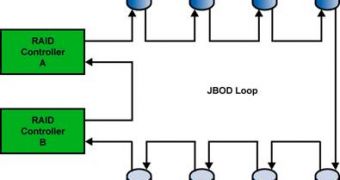First of all, what is an eSATA JBOD enclosure? Well, from its name, you can bet it is an enclosure using the eSATA interface and the JBOD "standard". The very fast transfer rate of the eSATA interface is mixed with the more flexible standard JBOD to create an enclosure with a maximum capacity of 3000GB and the great advantage of not requiring hard disk drives of the same storage capacity. Back to the basics, in this article we will use the term "enclosure" as a case inside which hard disk drives are stored and an interface that connects a number of drives to the rest of the PC.
Next comes the eSATA, which is the short for "external SATA", and besides USB and FireWire, is an interface that lets people connect external devices to a computer. ESATA transfers data at around 2400 Mbits/s, so it is much faster that either USB (which tops at about 480 Mbits/s) or Fire Wire variant B that reaches around 786 Mbits/s. Because of that massive speed increase, eSATA makes it as a prime candidate for data transfer in intensive applications. A lot like the famous - but sometimes too expensive, rigid and complicated - RAID, the JBOD lets users stack a number of hard disk drives in order to have more storage space. JBOD stands for "Just a Bunch of Ordinary Disks" and it works just like an opposite of disk partitioning. Instead of slicing one disk into multiple partitions, JBOD allows you to join a number of hard disk drives into one bigger drive. From the operating system's point of view, only a single drive will be present, as the JBOD standard works at the hardware level. RAID too can do this, but JBOD is more flexible as it works with disk of different sizes.
There are a few drawbacks too, mainly the price, which is quite high for an eSATA JBOD dedicated enclosure (about $289 without the hard disk drives) and the host computer must have a free PCI-E slot available. There are some motherboards out there that have internal JBOD capacity built-in and in that case, you may consider yourself lucky, as you can use the JBOD chip for the motherboard and save some serious money. As for the operating system requirements, Windows XP or Windows 2000 or Windows Vista should do nicely as will just about any Linux distribution with a 2.6 kernel.

 14 DAY TRIAL //
14 DAY TRIAL //